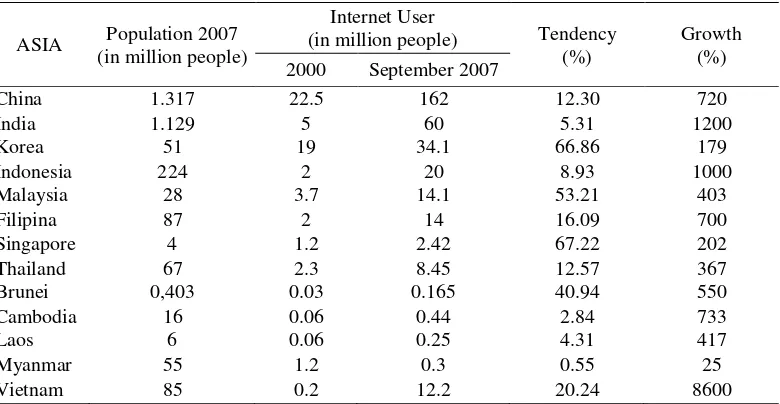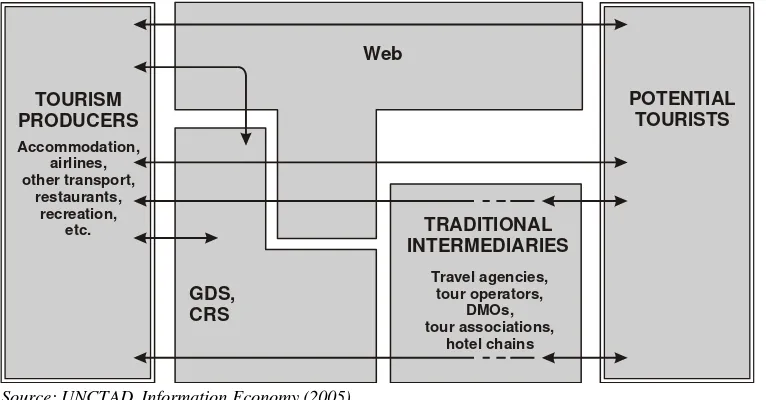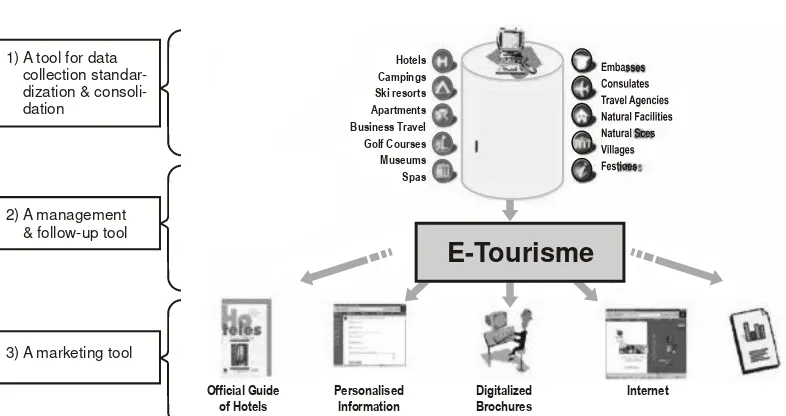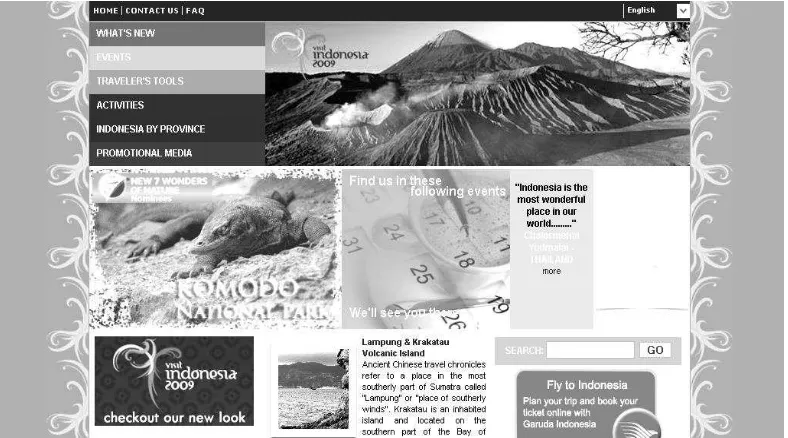Journal of Indonesian Economy and Business Volume 25, Number 2, 2010, 190 – 200
THE APPLICATION OF E-TOURISM IN SMALL AND MEDIUM-SCALE
TOURISM IN INDONESIA: A STRATEGIC MANAGEMENT VIEW
Ananda Sabil Hussein
Universitas Brawijaya misterhussein@gmail.com
Untoro Widagdo
Universitas Brawijaya untoro.widagdo@yahoo.co.id
Yeni Asriwulan
Universitas Brawijaya yeniasriwulan@yahoo.com
ABSTRACT
Tourism sector is one of state’s income that cannot be separated from the roles of small and medium scale business unit. In accordance with the development of science and technology, tourism sector cannot be separated with the application of information technology commonly called as E-Tourism. In general, E-Tourism is an application of information technology in the field of tourism in order to achieve effectiveness and efficiency in promoting the tourism sectors in Indonesia. Its application in tourism sector can be used as a medium to promote virtual promotion in order to get wider markets. It is also known that most of the tourists who come to Indonesia are from developed countries and they are familiar with the application of ICT. By applying E-Tourism tourists and prospective ones are able to access tourism information fast and accurately. It is beneficial for small and medium-scale businessmen. The article attempts to give a description about the effects of E-Tourism on small and medium-scale business unit in Indonesia. It is expected that those involved in tourism business are able to formulate a strategic marketing that can provide competitive advantages, while for researchers it is hoped that the article will be beneficial for future research related to E-Tourism .
Keywords: Tourism, small and medium scale business unit, E-Tourism, ICT, Strategic marketing
INTRODUCTION
Tourism sector provides a significant contribution to the economic development of Indonesia. Tourism has significant roles in creating job market, investment and contribut-ing positively to economic development of a
Santoso (2002) states that tourism sector is a very promising business in the future. The statement was based on the statistic released by World Tourism Organization (WTO) which predicted that the number of international tourists will be 1,046 billion in the year 2010 and 1,602 billion in the year 2020. 231 million will be in Eastern Asia and 438 million are in Pacific region. World tourism is predicted to be able to generate an income of US$ 2 trillion in 2020.
According to Swasono in Arifin (2008), the tourism development in Indonesia has to cover several aspects such as: (i) increasing the welfare of the society by creating new jobs; (ii) keeping the sustainable development of tourism sector in order to provide social and economic impacts on the society and maintaining environmental quality; (iii)
in-creasing tourists’ satisfaction and expanding
the markets of tourism; (iv) creating conducive climate to support productive, transparent and free from nepotism tourism development.
Indonesia’s tourism development cannot
be separated from the development of small and medium scale tourism business units. The
development of small and medium business unit can be done by maximizing internet-based information technology (ICT). The develop-ment of internet-based tourism is often called E-Tourism. It is supported by the increasing number of internet users around the world. The majority of tourists coming to Indonesia are mostly from developed countries where ICT is commonly used daily.
The data from www.worldstats.com in Arifin (2008) show that the numbers of internet users in many countries have been increasing significantly. Internet can be used as media to promote tourism products and services widely and efficiently in Indonesia. Internet provides tourism information accurately and could enables tourists to make tourism transactions such as reserving hotel rooms and so on.
E-Tourism changes traditional tourism marketing into virtual one which is faster, more practical, and more complete.According to UNCTAD (2005), E-Tourism bridges pro-viders of tourism services and prospective tourist through website. Website in E-Tourism can replace the position of travel agents, Table 1. Data of Internet User All Over the World
ASIA Population 2007 (in million people)
Internet User
(in million people) Tendency (%)
Growth (%) 2000 September 2007
China 1.317 22.5 162 12.30 720
India 1.129 5 60 5.31 1200
Korea 51 19 34.1 66.86 179
Indonesia 224 2 20 8.93 1000
Malaysia 28 3.7 14.1 53.21 403
Filipina 87 2 14 16.09 700
Singapore 4 1.2 2.42 67.22 202
Thailand 67 2.3 8.45 12.57 367
Brunei 0,403 0.03 0.165 40.94 550
Cambodia 16 0.06 0.44 2.84 733
Laos 6 0.06 0.25 4.31 417
Myanmar 55 1.2 0.3 0.55 25
Vietnam 85 0.2 12.2 20.24 8600
Journal of Indonesian Economy and Business May tourism transactions such as buying tickets, reserving a hotel room, restaurants and so on.
However, E-Tourism application in Indonesia is not an easy matter. It needs the infrastructure readiness to support it. Besides, it needs the availability of human resources who are capable of mastering technology to apply E-Tourism in small and medium tourism business in Indonesia. Some areas such as Bali and North Sumatera have been applying E-Tourism. The article discusses the application of E-Tourism in Indonesia, the arising problems, and the suggestions to develop E-Tourism in Indonesia.
THE APPLICATION OF ICT IN TOURISM SECTOR
Information and communication technol-ogy (ICT) in tourism sector as online marketing media. E-Tourism is an application of information technology to increase efficiency in tourism sector and provide tourism services to customers .It is an accessible tourism marketing strategic concept. Tourism provides services to a person or a group of people wanting to visit tourist objects..
Caribbean Tourism Organization (2005) defines E-Tourism, “A dynamic interaction between Information and Communication Technologies (ICTs) and Tourism exists. Each transforms the other: ICTs are applied to tourism processes to maximize efficiency and effectiveness of the organization, tourism unites Business Management, Information and Communication”. Based on the definition of E-Tourism Caribbean Tourism Organization (2005) it can be concluded that there are three components of E-Tourism namely; ICT (Information and Communication Technolo-gies), Tourism and Business.
Tourism development does not emphasize only on the beauty of a tourist object, but it effective and innovative tourism marketing strategy. In E-Tourism concepts there are some marketing aspects. According to Wahab (1997: 27), tourism marketing is a management process conducted by national tourism organization or groups of tourism industries to identify tourists willing to make a trip or having the potential to make one.
Tourism marketing is the main factor in E-Tourism to compete in attracting tourists. Through E-Tourism, provider can identify the needs, motivation, things that the tourists like and dislike. Besides, the information can be updated continuously.
According to UNCTAD (2003) the use of ICT in tourism market can be used as the basis of strategic decision making in tourism and the basis to achieve effective changes. It can be seen from the development of infrastructure, human capacity, and integrated concepts in order to get income from tourism sector in a global tourism market.
In Issues Brief (UNCTAD, 2005), it was stated that information technology provides impacts on the promotion, marketing and the selling of tourism. The people impacts derive from the use of E-Tourism in doing radical transformation in tourism industry. At present, people search for tourist objects in the internet. Therefore, the use of internet becomes very important in developing Indonesia’s tourism especially E-Tourism.
Based on case studies in Africa (Andeka, 2006), it was found out that that innovation in tourism marketing should be attained in international contexts, referring to providers in developed countries. It can increase the value of transaction and generate big profit (85%). The same case was also found in Carabia (80%), or in Asia as shown by Thailand (70%) and India (40%). Indonesia can apply internet-based E-Tourism so that wider markets can be achieved.
By using internet a wider and unlimited marketing access will be available to be accessed from around the world including information about tourism. Therefore, the use of information technology network by small and medium scale tourism business is a
breakthrough. E-Tourism is viewed as helpful in optimizing potencies in developing tourism.
According to Andeka (2006) there are three components in E |Tourism namely : (1) data collecting, standardizing, and consolidat-ing, (2) management and implementation, and (3) marketing. There are three levels of E-Tourism namely: (1) Data collecting system is the one in charge of standardizing and consolidating. There are some elements in this system such as hotel, tourist objects, and important activities that can be accessed by consumers. Therefore, data collecting, standardizing and consolidating become the first level; (2) management dan follow-up which cover system design are arranged based on the information from standardizing and consolidating units; (3) the system application to support marketing. The three levels above are the levels in disseminating information to tourists or prospective ones.
THE APPLICATION OF E-TOURISM IN INDONESIA
At present the application of E-Tourism in Indonesia has been used by Tourism Offices to support Visit Indonesia program. |It can be
TOURISM PRODUCERS Accommodation,
airlines, other transport,
restaurants, recreation,
etc.
GDS, CRS
Web
TRADITIONAL INTERMEDIARIES
Travel agencies, tour operators,
DMOs, tour associations,
hotel chains
POTENTIAL TOURISTS
Source: UNCTAD, Information Economy (2005).
Journal of Indonesian Economy and Business May 194
seen in website belong to the Tourism Office of |Yogyakarta, Bali, Palembang. Those websites function as online information to |Indonesian as well as international community.
The arrival of tourists to Indonesia cannot be separated from the promotion conducted by either tourism offices or those involved in tourism business. The use of E-Tourism as virtual media for promotion is effective to attract tourists to come to Indonesia. E-Tourism is able to generate more income and provide the information availability for tourists. E-Tourism is also able to reduce the existence of foreign travel agents. Thus, all the income can be claimed by Indonesian tourism.
One of the E-Tourism websitesin Indone-sia is www.my-indoneIndone-sia.info. It can be seen in the website that the application E-Tourism in Indonesia is still limited to provide tourism information through internet, and it is still far from the real E-Tourism concepts. E-Tourism does not only provide tourism information but also provide online booking, and so on.
Based on the fact about the application of E-Tourism in Indonesia, it can be concluded that much improvement especially about the content E-Tourism website in Indonesia is needed. Andeka (2006) offered a concept of E-Tourism which cover online booking (2006) accommodation, tourist objects, activities and facilities, events, and transportation.
The concept proposed by Andeka (2006) can be used as an example of a better E-Tourism in Indonesia. Every tourist faces the problems of time and money constraints in choosing a tourist object. they face the problems of accommodation, the choice of the objects, transportation and so on. It is impossible to take care of all the problems by him/herself. Therefore, Andeka offers the online booking concept. He also offers the concept of online booking packages where everything is taken care of the convenience of tourists.
Online booking concept offered by Andeka makes it possible to have electronic transactions through internet. Online booking needs online payment mechanism through a 1) A tool for data
collection dization & dation
2) A management & follow-up tool
3) A marketing tool
Official Guide of Hotels
Personalised Information
Digitalized Brochures
Internet
E-Tourisme
Hotels Campings Ski resorts Apartments Business Travel Golf Courses Museums Spas
Source: UNCTAD, E-Tourism Initiative, 2004 dalam Andeka (2006).
financial institution such as a bank. On one hand, internet transaction in Indonesia is still vulnerable in terms of its security. Thus, further improvement in the online booking concept needs to be done, especially, in terms of online booking payment mechanism.
The use of E-Tourism in Indonesia is mostly managed by the Tourism Office. However, it also possible to involve other parties like travel agents. It is also possible for Tourist Offices to hold website maintenance trainings for other parties involved. These trainings will be good steps in developing the concept of E-Tourism.
TOURISM SMALL AND MEDIUM SCALE BUSINESS UNIT IN INDONESIA
Small and Medium Business Unit (SME) in this article refers to the definition given by the Ministry of Cooperation and Small and Medium Scale Business Unit. A business unit is categorized as small when its assets is less than Rp 200 millions excluding the land and building. The transaction is less than Rp 1 billion/year. |Medium scale has assets of more
than 200 million and the transaction is Rp 1-10 billion/year.
According to Arifin (2008) the existence of Small and Medium Scale business in Indonesia in times of global crisis is taken into account for the following reasons:
SME is tougher in facing global crisis due to the fact that the business is not related to export-import, it is not related to interest rate, it is not related to exchange rate, and it uses local products.
SME support future industries.
SME support real sectors because its growth does not create bubble economy. SME is the biggest contributor of
Indonesia’s Gross Domestic Product with an average of 54%-57%.
SME absorbs the biggest man power in Indonesia, which is about 96%.
SME is the biggest industry in Indonesia. From 1997-2006, 99% business is SME.
The biggest problem faced by SME in Indonesia are the low productivity, low added
Source: www.my-indonesia.info (2009).
Journal of Indonesian Economy and Business May 196
value, and low quality of the products. The problem is caused by some factors such as lack of technology mastery, lack of en-trepreneur skills and so on. Efforts to improve the competitiveness of SME need to be done
Tourism sector is closely related to SME. Indonesia as one of the tourist objects tries to develop its tourism sector to support its economic growth. Tourism sector absorb 84,95 percent of men power (www.detikfinance.com).
Indonesia’s tourism has great potential as one of the sectors that can be relied on to develop its economic growth. There are many tourism-based SME that can support the development of tourists objects. Many parties such as travel agents, restaurants, hotels, and guides will be involved if the SME is developed. Other sectors will also be involved such as handicraft, specific food, transporta-tion, telecommunication and so on.
For the past few years tourism sector in has been disturbed by several problems such as terrorism and domestic security, avian flu,
swine flu, and natural disasters. Indonesia’s
tourism cannot compete with our neighbouring countries such as Malaysia and Thailand. Therefore, since 2008 the government of Indonesia has been promoting Indonesia by launching a program called Visit Indonesia Year.
With the development of information technology and globalization, the use of ICT needs to be developed. Many people in the world including in Indonesia have been using internet. |Based on the data of APJII the development of internet in Indonesia in 2008 has made significant progress. Out of 206,264,595 people there were 2 million (about 1%). The number rose to 20 million users out of 224,481,720 people (about 8.9%) in 2007 and in 2008 there are about 25 million netters out of 237,512,355 people (about 10.5%). By the end of March 2008, 241,000 broadband internets were installed all over Indonesia.
The application of E-Tourism is intended to introduce business profile and products offered by SME, widen marketing network, introduce the use of information technology to small and medium scale businessmen, and educate them to be responsive toward the importance of information .
Bali has been using E-Tourism to introduce its business. According to I Gusti Bagus (2008) the system can shorten the distribution chain. It is also cheap compared to door-to-door promotion, so that the weakness in marketing network can be solved by using information technology.
The application of E-Tourism is some-thing novel. It is also perceived as expensive,
Source: Andeka (2006)
complicated, and it needs sophisticated knowl-edge. Sometimes SME focuses on production and short-term needs, not on market demands. Therefore, deeper understanding on manage-ment, appropriate production techniques can be accessed by means of internet and information technology.
There are some obstacles in implementing E-Tourism in SME sector. Evaluation about the use of E-Tourism needs to be done. The local as well as central government need to provide facilities to support the application of E-Tourism.
Expertise in the field of ICT is also needed. Therefore, cooperation with ICT experts needs to be supported so that the application of E-Tourism by SME will be beneficial to promote their business and to widen their market share.
EFFORTS TO DEVELOP E-TOURISM FOR SMALL AND MEDIUM SCALE TOURISM IN INDONESIA
The development of E-Tourism for tourism SME is very much needed because of the fact that tourism sector in Indonesia is very promising. Besides, the development of tourism SME in Indonesia also supports other sectors such as travel agents, restaurants, hotels, and guides. The development of E-Tourism in Indonesia will also transform traditional tourism development model in order to keep up with the needs.
The use of internet as media to promote tourism in Indonesia is not adequate enough. The information in the internet is not integrated. Therefore, the use of internet is far from the real concept of E-Tourism. E-Tourism inIndonesia is left behind compared to those in neighboring countries such as Singapura, Malaysia, and Thailand. Learning from the experience of Malaysia, we can conclude that the problem faced by Indonesia in developing its tourism is the inavailability
of comprehensive information about its tourism. That is the reason why Indonesia is left behind compared to Malaysia, Thailand, and Singapura. E-Tourism is expected to generate more income from tourism sector. The availability of some information related to accommodation, tourist objects, prices, and schedule will be helpful for tourists in making decision to come to Indonesia.
E-Tourism in Indonesia is limited to providing information and the majority is still managed by local as well as central govern-ment. In fact, it should be managed by product and service providers such as travel agents, hotels, handicraft industry in order to [provide informative, fast, accurate websites that can cater the needs of tourists or prospective ones. There should be a paradigm shift that the started by giving trainings to those involved in the tourism business. Providing technical assistance is also very much needed. At the beginning, the roles of the government will be dominant since in general the concept of E -Tourism and the use of ICT is still something novel for most people..
Journal of Indonesian Economy and Business May
Figure 6. E-Tourism Development Concepts on Small-Medium Scale Tourism in Indonesia
There are some concepts that can be used to develop E-Tourism for SME tourism in seminate the importance of E-Tourism appli-cation is very much needed. In general, those involved in tourism SME are not familiar with the use of ICT as promotion media.
The next step is by introducing the use ICT to those involved in the business. Infrastructure and skill usually become the obstacles in developing E-Tourism in Indone-sia. Thus, the government should introduce ICT and train them to use it. The government as well as the non-government organizations should also evaluate the programs.
Training
The concept of E-Tourism provides positive benefit to strategic marketing for SME tourism. However, the problem faced by SME is expertise in ICT. The government can
cooperate with private sectors to hold workshops and trainings about ICT and also about how to create and maintain website for SME to support the application of E-Tourism.
2. Relationships with expert
Trainings will not be enough because they are short-term programs. It takes time to master the knowledge ICT and about the process of creating websites so the govern-ment should act as a facilitator to enable the parties involved to master such knowledge. SME can also cooperate with website providers to become facilitators for them.
Networks, cluster, and community
The development of E-Tourism for tourism SME in Indonesia can also be done by setting up network, cluster, and community. To integrate tourism information, those involved in tourism SME can make a network functioning as the collector of tourism information. The formation of network can be done by creating a community categorized based on cluster or tourism SME types. From such community they can gather tourism information in Indonesia and upload it in the website. The tourism information must always be updated. It is an important action for an E-Tourism website because complete informa-tion will attract more tourists to visit Indonesia.
development cannot be divorced from the roles of small and medium scale business (SME). With the development of science and technology, tourism sector cannot be separated from the use of E-Tourism. However, the development of E-Tourism support
Indone-sia’s tourism cannot be done well. maksimal.
The development of E-Tourism in Indonesia is left behind compared to that in Singapura, Malaysia, and Thailand.
The weaknesses of E-Tourism application lies in the unavailability of tourism informa-tion in Indonesia Besides, the use of ICT in E -Tourism concept is still very shallow, that is, it is limited to providing tourism information without adding value added such as online booking and so on. ICT in Indonesia is still developed by the government, not by the businessmen involved.
The development of E-Tourism concept is inevitable at present due to the development of science and technology. It is supported by a great number of ICT users in the world. There are many advantages in using ICT in E-Tourism concept in Indonesia. Among other is the wider market share because of the virtual promotion which is accessible to be accessed from all over the world. It will be very beneficial in developing tourism sector in Indonesia together with the development of local tourism.
It needs the cooperation with many parties to develop the application of E-Tourism for SME in Indonesia. The roles of government, private sector, and businesspersons involved need to be synergized to develop E-Tourism for SME in Indonesia. Strategic evaluation must be done one timely basis in order to achieve maximum results. To conclude,
Indonesia’s tourism is expected to be able to develop and generate welfare for the people of Indonesia, especially, for those involved in tourism SME by applying good E-Tourism.
REFERENCES
Aliya, Angga, 2009. “Pertumbuhan Ekonomi Lambat, Garut Genjot Sektor Pariwisata [Slow Economy Growth, Garut
Accelerat-ing Tourism Sector]”. Published Paper Available at: http://www.detikFinance. com accesed on July 10, 2009.
Arifin, Sjamsul, 2008. Bangkitnya Perekono-mian Asia Timur [The Rise of East Asian Economy]. Jakarta: PT.Elex Media Komputindo.
Arifin, Sjamsul, 2008. Masyarakat Ekonomi Asean (MEA) 2015 [Asean Economic Community]. Jakarta : PT.Elex Media Komputindo.
Asosiasi Penyelenggara Jasa Internet Indone-sia, 2008. Internet user. Available at: http://www.apjii.or.id accessed July 15, 2009.
Caribbean Tourism Organization, 2005. “ E-Tourism”. Published Article Available at: http://www. onecaribbean.org accessed on July 15,2009.
Fitanto, Bahtiar, 2009. “SME dan Daya Saing Bangsa” [SME and Nation Competi-tiveness], Unpublished Slide presentations on subjects Indonesian economy. Yogyakarta: UGM.
Santosa, Setyanto P., 2002. “Pengembangan
Pariwisata Indonesia”. Published Article, Available at: http://www.kolom.pacific. net.id accessed July 15, 2009.
Wahab, Salah, 1997. “Tourism Marketing”, translation by Frans Gromang. Jakarta : Pradnya Paramita.
Tanaamah, A.R dan Augie D.M., 2006. “ E-Tourism Based E-Tourism in Indonesia”, Unpublished paper.
UNCTAD. 2003. “Sustainable Tourism for
Journal of Indonesian Economy and Business May 200
UNCTAD. 2004. “Unctad’s E-Tourism Initiative”, Published Article Available at: http://www.unctad.org accessed on July 16, 2009.
UNCTAD. 2005. “Information Economy”, Published Article, Available at: http://www.unctad.org accessed on July 16, 2009.
UNCTAD. 2005. “E-Tourism in Developing Countries”, Published Article, Available at: http://www.unctad.org accessed July 16, 2009.
UNCTAD. 2007. “E-Tourism Initiative: Helping developing countries to become autonomous”. Published Article, Availa-ble at: http:// www.unctad.org accessed on July 16, 2009.





